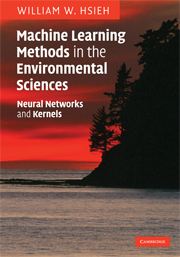 Published by
Published by Cambridge University Press
Neural Network and Kernels William W. Hsieh
Machine learning, a major subfield of computational intelligence (i.e. artificial intelligence), uses computational methods to extract information from data. Neural network methods, generally regarded as forming the first wave of breakthrough in machine learning, became popular in the late 1980s, while kernel methods arrived in a second wave in the mid-to-late 1990s.
Machine learning methods began to infiltrate the environmental sciences in the 1990s. Today, thanks to their powerful nonlinear modelling capability, they are no longer an exotic fringe species, as they are heavily used in satellite data processing, in general circulation models (GCM) for emulating physics, in the post-processing of GCM model outputs, in weather and climate prediction, air quality forecasting, analysis and modelling of environmental data, oceanographic and hydrological forecasting, ecological modelling, and in the monitoring of snow, ice and forests, etc.
This book presents machine learning methods and their applications in the environmental sciences (including satellite remote sensing, atmospheric science, climate science, oceanography, hydrology and ecology), written at a level suitable for beginning graduate students and advanced undergraduates. It is also aimed at researchers/practitioners in environmental sciences interested in applying these new methods to their own work.
More
details at the Cambridge Univ. Press site
Resources website for the
book (including video lectures)
Book can be ordered from
www.amazon.com